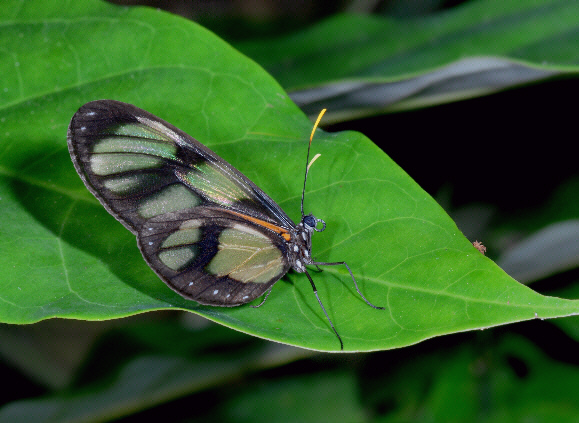
Introduction
The Ithomiini comprises of 376 known species, although it is likely that at least another 30 will be discovered in the near future. All are confined to the neotropical region. Ithomiines are unpalatable to birds, and are consequently mimicked in appearance by many other species. These include other unpalatable species ( Müllerian mimics ), not only from the Ithomiinae but also from several other butterfly families. There are also a large number of edible species ( Batesian mimics ) which have evolved similar patterns. Birds have the ability to memorise butterfly patterns and so learn to avoid eating noxious species, but are also fooled into ignoring similarly marked edible species.
Ithomiines are characterised by having small eyes, slender abdomens and long drooping antennae that lack distinct clubs. Males have a plume of long androconial scales or “hair pencils” on the costa of their hindwings. These are hidden from view when the butterflies are at rest, but are displayed when the wings are held open during courtship. Other Ithomiine characteristics include a very slow and deep wing beat, and a preference for inhabiting the darkest recesses of the forest understorey.
There are basically 2 types of Ithomiine. The first type are the black and orange-banded “tigers”, many of which are mimicked by other species due to their unpalatability to birds. The second type are the “glasswings”, recognised by their transparent or translucent wings, prominent veins, and orange wing margins. Many genera contain examples of both of these types, and in some cases an individual species may produce adults of both forms according to location.
Most novices find the Ithomiini very difficult to identify. Using only the patterns to identify species is very unreliable because there are so many similar species. Also many species produce a variety of different colour forms according to locality and season. The best approach therefore is to use the hindwing venation and other anatomical features to identify the genus, and to then look at the wing patterns to short-list the likely species.
The genus Callithomia includes only 3 species, of which alexirrhoe and hezia fall loosely into the tiger pattern category, being marked with cream and orange on a black ground colour.
The species featured here, Callithomia lenea falls into the glasswing group and is marked similarly to Methona or Thyridia but is much smaller than either, and easily recognised due to the greenish translucency of the wings, and the orange costal streak. It is a member of an assumed Müllerian “mimicry ring” known as the confusa complex, involving Thyridia psidii, Godyris dircenna, Methona curvifascia, M. confusa ( Ithomiinae ), Lycorea ilione phenarete ( Danaini ) and various Tiger moths such as Chetone heliconioides ( Arctiidae : Pericopiinae ).
Callithomia lenea is found from Panama to Bolivia.
Habitats
This is a lowland and mid-elevation rainforest species found at altitudes between sea level and about 1000m on the eastern slopes of the Andean foothills.
Lifecycle
I can find no published information on lenea. DeVries states that Callithomia alexirrhoe oviposits on an unidentified sub-canopy woody vine in Costa Rica. Haber gives the larval foodplant of the same species as Solanum sanctae-clarae. It is therefore reasonable to assume that lenea caterpillars also feed on Solanaceae.
Adult behaviour
The butterfly is widespread and fairly common but is nearly always encountered singly. Both sexes visit Lantana, Eupatorium, Hamelia and Psiguria flowers at dawn in forest edge habitats. Solitary males are commonly encountered after being disturbed from rest on the foliage of sapling trees in light gaps in damp areas of the forest understorey.
Males sequester pyrrolizidine alkaloids from Heliotropium, Tournefourtia, Myosotis ( Boraginaceae ), Eupatorium, Neomiranda and Senecio ( Asteraceae ). These chemicals confer toxic qualities to the butterflies which deter bird attacks. The chemicals are also used in the production of pheromones. Often the males of several Ithomiine species will gather together at communal leks, where they release these pheromones from hair-like androconial scales on the leading edge of their upperside hindwings. These attract more males, which in turn release further pheromones. After a few days the lek may include 50 or more adults comprised of as many as dozen different species. Passing females are attracted to the leks by the complex fragrances. Their presence stimulates the males to open their wings and release further pheromones that entice them into copulation. Females obtain sustenance from nectar, and also visit bird droppings which provide them with a source of nitrogen that assists with the development of their eggs.
